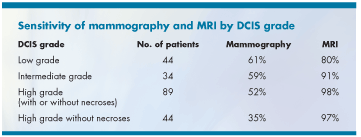MRI accurately detects high-grade DCIS
In a breast cancer screening population, magnetic resonance imaging (MRI) was more effective than mammography in detecting ductal carcinoma in situ (DCIS), especially high-grade lesions that are most likely to progress
ASCOIn a breast cancer screening population, magnetic resonance imaging (MRI) was more effective than mammography in detecting ductal carcinoma in situ (DCIS), especially high-grade lesions that are most likely to progress, according to a German study reported at the 43rd Annual Meeting of the American Society of Clinical Oncology (abstract 1504).
Cristiane K. Kuhl, MD, professor of radiology, University of Bonn, Germany, noted that while mammography is the gold standard for diagnosing DCIS, there are rising concerns about the overdiagnosis of low-grade lesions that are not clinically meaningful. MRI has recently established itself as superior in the diagnosis of invasive cancer in high-risk women, but is considered inferior for DCIS detection. This has been based, however, on small studies with selection bias.
The prospective study included 7,319 women referred to a dedicated breast unit for screening or for diagnostic assessment (ie, an unselected cohort). Women underwent bilateral mammography with at least two views, plus spot compression views where appropriate, and high-resolution bilateral MRI.
A total of 167 women received the final pathologic diagnosis of pure DCIS. This included 44 low-grade lesions, 34 intermediate-grade lesions, and 89 high-grade lesions.
Of these women, 58% had been referred for regular mammography screening, 8% for high-risk screening, 26% for follow-up after breast cancer, and 7% for clinical symptoms. The majority (56%) were referred for MRI due to an abnormal mammogram. Of those with a normal mammogram, 17% were concerned women of average risk, 11% had MRI as follow-up after breast cancer, 5% were high-risk women, 3% had clinical symptoms, and 8% were referred because of a previous incidental finding on an MRI performed to explore a mammographic abnormality unrelated to the DCIS.
Women were assessed for mode of detection and the biologic profile of the DCIS (size, nuclear grading, hormone-receptor status, and HER2 status).
Of the 167 DCIS cases, the diagnosis was made only by MRI in 153 cases (92%), and only by mammography in 93 cases (56%) (P < .0001), Dr. Kuhl reported.
Across all three grades, MRI detected more cases of DCIS than mammography, and this was significant for intermediate-grade and high-grade DCIS (see Table). Among cases diagnosed by MRI, 69% were high-grade lesions; among the mammography-diagnosed cases, 17% were high-grade. Two of the high-grade DCIS cases were detected by mammography only, whereas 43 were detected by MRI only.
MRI-detected lesions were also more likely to be estrogen-receptor negative and HER2 positive, compared with mammography-diagnosed lesions, Dr. Kuhl said.

There were no differences between the lesions detected by MRI vs mammography in terms of patient age, history of breast cancer, familial risk, breast density, or menopausal status.
"MRI was more sensitive than mammography for diagnosing DCIS, and particularly high-grade lesions. Over half of all high-grade lesions were diagnosed only by MRI," Dr. Kuhl concluded. "MRI detects DCIS with an aggressive biological profile." She noted that it is important to diagnose high-grade DCIS for breast cancer prevention. "This is another piece of evidence that MRI is the new gold standard, adding to information that it is better for detecting invasive cancer in high-risk patients," she said. Dr. Kuhl's full report of the study was recently published (Lancet 370:485-492, 2007).
Claudine Isaacs, MD, of the Cancer Assessment and Risk Evaluation Program, Lombardi Cancer Center of Georgetown University, commented at ASCO that this is the only study of MRI that has focused on the general screening population and is also one of the largest, which makes the data reliable. However, because the study was conducted in a large tertiary breast cancer center with expertise in MRI, the findings cannot be extrapolated to other centers, she said.
Furthermore, Dr. Isaacs said, there is no evidence that early detection prolongs life. "Be cautious, therefore, in extrapolating these findings to women with average risks," she said.